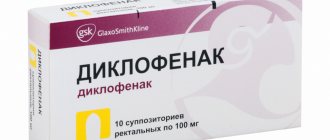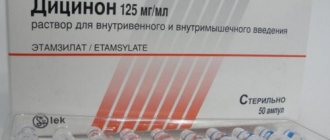Pharmacodynamics and pharmacokinetics
The drug is applied topically and has anti-inflammatory and venosclerotic effects. Area of application: proctology . Heparin enhances the regeneration of connective tissue, prevents blood coagulation to hemorrhoids, prevents thrombus formation , and has an anti-edematous effect. Thanks to heparin, the number of relapses is significantly reduced. By acting on the vascular endothelium, heparin prevents the formation of edema and a stable fibrin thrombus .
Prednisolone is a glucocorticosteroid of synthetic origin and reduces the activity of inflammatory mediators ( lysosomal enzymes , prostaglandins , kinin and histamine ). Thanks to the vasoconstrictor effect, a decrease in exudation is achieved, the severity of the allergic reaction is reduced (as a result of suppression of cytokines and macrophages ). Lidocaine provides a local anesthetic effect, which is achieved by blocking sodium, voltage-dependent channels, which leads to a decrease in the generation of impulses.
Hepazolon
Gepasolone is a combined antihemorrhoidal drug for topical use, which has anti-inflammatory, antithrombotic and venosclerotic effects. This drug contains three active substances that determine its pharmacological action: heparin, prednisolone and lidocaine. In order for the reader to have a holistic understanding of what hepazolone is, it makes sense to talk sequentially about each of its components.
Heparin prevents the formation of blood clots, prevents blood clotting in hemorrhoids, eliminates swelling, promotes connective tissue regeneration, accelerates the healing process and reduces the likelihood of recurrence of the disease. Suppresses reactions that cause blood clotting and form a fibrin clot. At the dosage in which it is included in hepazolone, heparin, together with blood plasma antithrombin III, prevents thrombosis by blocking factor Xa and inhibiting the transition of prothrombin to thrombin. By “taking out” the fibrin-stabilizing factor, heparin prevents the formation of a stable fibrin thrombus. And the final touch in heparin’s “personal file” will be a mention of its anti-inflammatory effect, which is also important for hemorrhoids: the drug has a beneficial effect on the vascular endothelium and neutralizes swelling.
Prednisolone is a synthetic glucocorticosteroid with an average duration of action. Reduces the synthesis, release and activity of biologically active substances-inflammatory mediators (including prostaglandin, histamine, kinin and lysosomal enzymes). Prevents the migration of cells to the inflammatory focus, reduces the lumen and increased permeability of blood vessels at the site of inflammation. Thanks to its vasoconstrictor effect, it reduces exudation (the release of fluid with proteins and leukocytes through the vascular walls into the tissues and cavities of the body).
Inhibits the activity of participants in allergic reactions: macrophages, cytokines and target cells. Protects target cells from “bloodthirsty” macrophages and sensitized T-lymphocytes. It has an anti-inflammatory and anti-allergic effect, reduces inflammation and associated discomfort in the anorectal area in the form of pain, burning, itching, and a feeling of increased moisture due to developed eczematous changes.
Lidocaine is a local anesthetic whose action is associated with the blockade of voltage-gated sodium channels, which, in turn, prevents the generation of impulses in the endings of sensory (afferent) neurons and the conduction of pain impulses along nerve fibers. Heparin, prednisolone and lidocaine together potentiate and complement each other's action, which helps achieve the best effect. Heparin and prednisolone are quickly and completely absorbed after administration into the rectum, penetrate the intestinal wall for several hours, then enter the liver and are excreted through the kidneys. The body also has no problems with the absorption and excretion of lidocaine.
Gepazolon is available in the form of rectal suppositories. For internal hemorrhoids, the suppository should be inserted into the rectum 1-2 times a day. In case of external hemorrhoids, the suppository is not completely inserted into the anus: in order to prevent it from “falling” into the rectum, the anus must be held with a gauze pad for 2-3 minutes until the suppository melts. The duration of treatment is on average 1 week. If necessary, the doctor can extend the treatment course to 2 weeks.
Indications for use
The drug is prescribed for fistulas , anal fissures , eczema , itching in the anorectal area caused by an inflammatory process. Instructions for use of Gepazolon it is recommended to use suppositories for thrombophlebitis of hemorrhoidal veins located in the perianal area.
For hemorrhoids (operated, thrombosed), the drug is prescribed as part of complex therapy.
The drug is prescribed before surgical treatment of diseases of the anorectal region.
Review of reviews on the treatment of hemorrhoids
Reviews from doctors about Gepazolon for hemorrhoids are positive. The drug has proven itself well in the treatment of proctological pathologies. The strong anti-inflammatory, analgesic, antithrombotic effect of suppositories eliminates problems with anal fissures and nodular hemorrhoids.
Patients note the effectiveness of the drug Gepazolon. After a course of treatment, inflammation in patients is eliminated, itching and swelling disappear. However, there are also negative reviews about the medicine. Some patients complain of a resumption of symptoms after stopping use.
Reviews from doctors and patients about Gepazolon suppositories are positive
Contraindications
Gepazolon ointment is contraindicated for infectious, fungal, viral and tuberculous lesions of the anorectal area. The medication is not prescribed for functional disorders of the blood coagulation system due to the risk of rectal bleeding .
Gepazolon suppositories are contraindicated in case of intolerance to heparin, lidocaine and prednisolone.
The drug Gepazolon is not used in pediatrics (age limit: 12 years).
During pregnancy and breastfeeding, Gepazolon ointment is contraindicated.
Side effects
Endocrine system: development of Itsenko-Cushing syndrome , functional suppression of the adrenal glands, development of “steroid” diabetes mellitus, decreased sensitivity to glucose.
Cardiovascular system: changes in the electrocardiogram indicating hypokalemia, arrhythmias , increased blood pressure, bradycardia .
Nervous system: dizziness, sleep disturbances such as insomnia .
Metabolism: increased sweating, removal of calcium from the body, formation of hypocalcemia .
All of the above side effects are caused by the action of prednisolone (glucocorticosteroid) and occur when taking the medication for more than 5 weeks.
Instructions for use of Gepazolon (Method and dosage)
Gepazolon suppositories, instructions for use
Treatment of internal hemorrhoids: Gepazolon suppositories are administered 1-2 times daily into the rectal cavity.
Treatment of external hemorrhoids: insert the suppository into the anus so that the base of the suppository can be felt from the outside. Until the suppository completely melts, it is recommended to hold the anus area with a gauze pad for 3 minutes. Otherwise, the therapeutic effect is not achieved due to the suppository “falling through” into the rectal cavity.
Duration of therapy – 1 week. Treatment can be extended up to 2 weeks if necessary.
Instructions for Gepazolon ointment
The ointment is used if hemorrhoids have already fallen out. In this case, they need to be lubricated up to 3 times a day.
Hepazolon sup rectal N 10
Compound
- Active ingredients: sodium heparin 120 IU, prednisolone 1.7 mg, lidocaine hydrochloride 10 mg; Excipients: witepsol N 15 – sufficient amount to obtain a suppository weighing 1.0 g.
Package
10 pieces.
pharmachologic effect
Gepazolon is a unique combined domestic drug for the treatment of hemorrhoids with a pronounced analgesic effect, proven effectiveness and safety of use.
Hepazolon, indications for use
External and internal hemorrhoids, including acute thrombophlebitis of hemorrhoidal veins in the perianal region, fistulas, eczema, itching in the anus caused by inflammation, anal fissures, preparation for surgery in the anorectal area, as part of complex therapy for thrombosed and operated hemorrhoids.
Contraindications
- Hypersensitivity to the components of the drug. — Viral, fungal, tuberculosis and other infectious processes of the anorectal area, disorders of the coagulation system with a predisposition to bleeding. — Pregnancy and lactation period. — Children's age up to 12 years.
Directions for use and doses
For internal hemorrhoids, insert the suppository into the rectal cavity 1-2 times a day. For external hemorrhoids, the suppository should not be inserted completely into the anus - its base should be palpated from the outside. Hold the anus with a gauze pad until the suppository completely melts (2-3 minutes), otherwise the suppository will “fall” into the rectum without having a therapeutic effect. The course of treatment is 7 days. On the recommendation of a doctor, the course can be extended to 14 days.
Side effects
The drug is usually well tolerated. No side effects were identified at the recommended dose of the drug. When using the drug for more than 5 weeks, systemic side effects associated with the action of prednisolone are possible: From the endocrine system: decreased glucose tolerance, “steroid” diabetes mellitus, suppression of adrenal function, Itsenko-Cushing syndrome. From the cardiovascular system: possible arrhythmias, bradycardia (in predisposed patients), ECG changes characteristic of hypokalemia, increased blood pressure. From the nervous system: insomnia, dizziness. Metabolic: increased excretion of calcium ions, hypocalcemia, increased sweating. Allergic reactions caused by lidocaine and heparin in the form of itching and irritation of the anus are possible.
special instructions
Patients who have previously had allergic reactions to other selective 5-HT3 receptor blockers have an increased risk of developing them with ondansetron. Ondansetron can slow down the motility of the large intestine, and therefore, its administration to patients with signs of intestinal obstruction requires special monitoring.
Storage conditions
In a dry place, protected from light, at a temperature not exceeding 25 C. Keep out of the reach of children.
Best before date
2 years.
Analogs
Level 4 ATC code matches: Betiol
Olestezin
Proctosedyl
Ultraproct
Relief
Anuzol
Posterisan Forte
Posterisan
Bezornil
Procto-Glyvenol
Glivenol
Proctosan
Analogs include the following drugs: Betiol , Anuzol , Relief Advance .
Drug analogues
Structural analogues of Hepazolon are not produced. Doctors may prescribe suppositories or ointments with similar therapeutic effects. For inflammation of the perianal area, the following is prescribed:
- Aurobin ointment is a combination product that contains triclosan, prednisolone, lidocaine, dexpanthenol;
- rectal suppositories Olestezin - an antihemorrhoidal agent with active ingredients: benzocaine, sulphaethidol, sea buckthorn oil;
- Proctosedyl ointment and suppositories with benzocaine, hydrocortisone, heparin, esculoside, framycetin;
- ointment for rectal and external use Gepatrombin G with heparin, prednisolone and lauromacrogol 600;
- local anesthetic Relief Advance with benzocaine and shark liver oil;
- Anuzol rectal suppositories with belladonna extract, zinc sulfate, xeroform;
- rectal suppositories Betiol with belladonna extract and ichthammol.
Important! Medicines are selected by the attending physician taking into account the disease, the patient’s tolerance of the active components, age, and concomitant pathologies.
Gepazolon price, where to buy
The price of Gepazolone in suppositories is 260 rubles per pack of 10 pieces.
The price of candles in Ukraine starts from 240 UAH for the same packaging.
The price of the ointment is approximately 200-300 rubles.
- Online pharmacies in RussiaRussia
ZdravCity
- Gepasolone supp.
rect. 10pcs Altfarm LLC RUR 356 order


